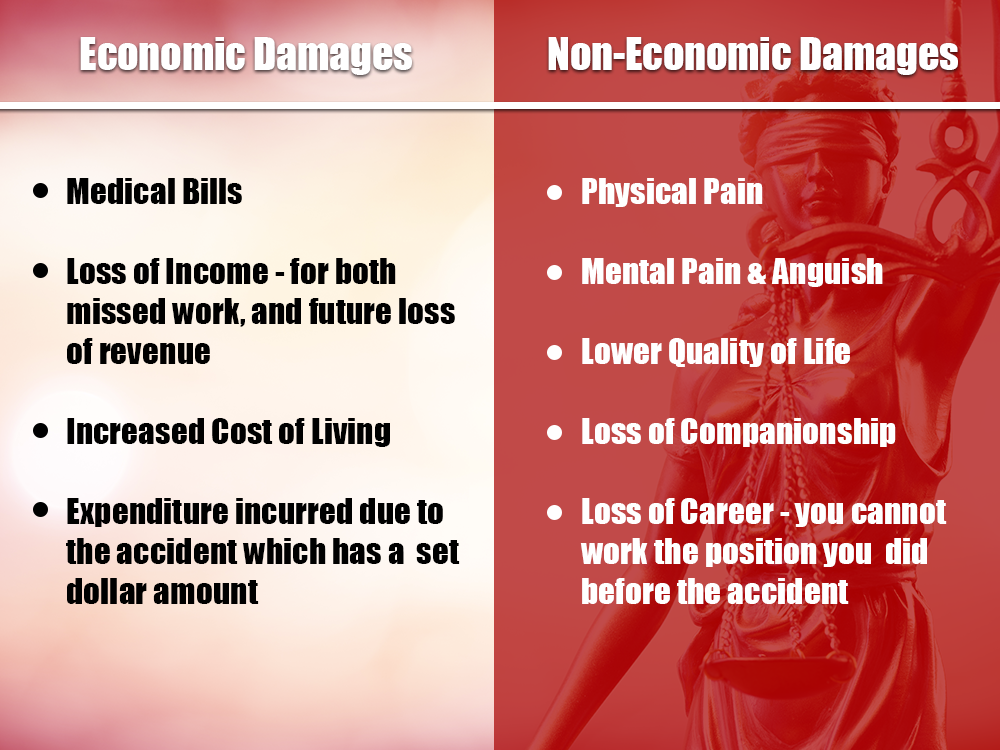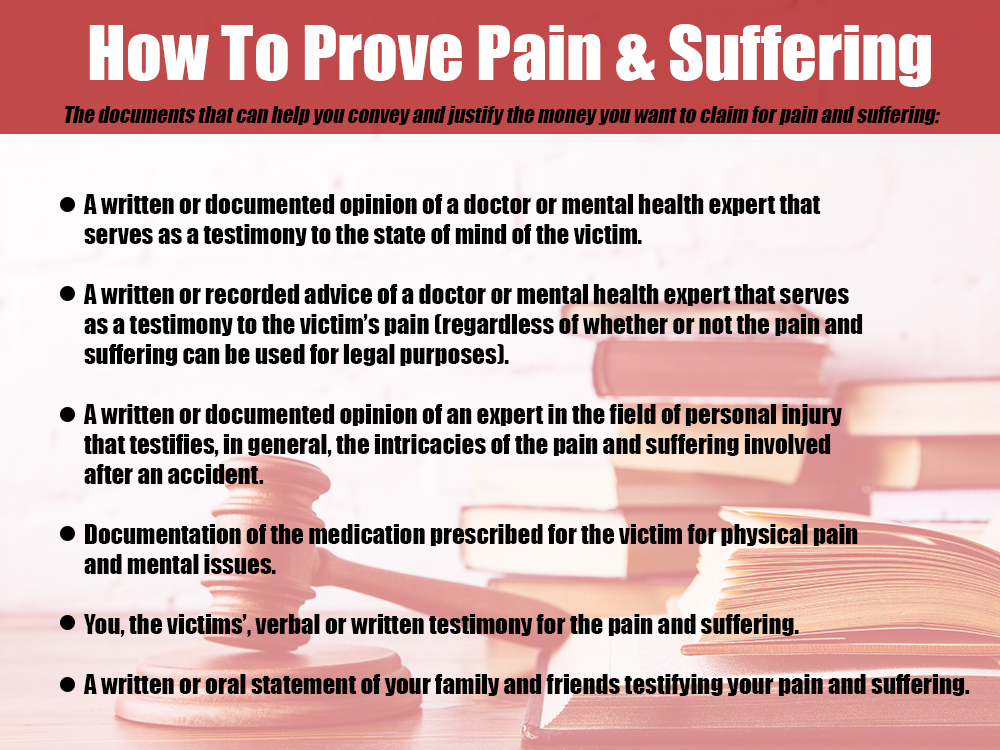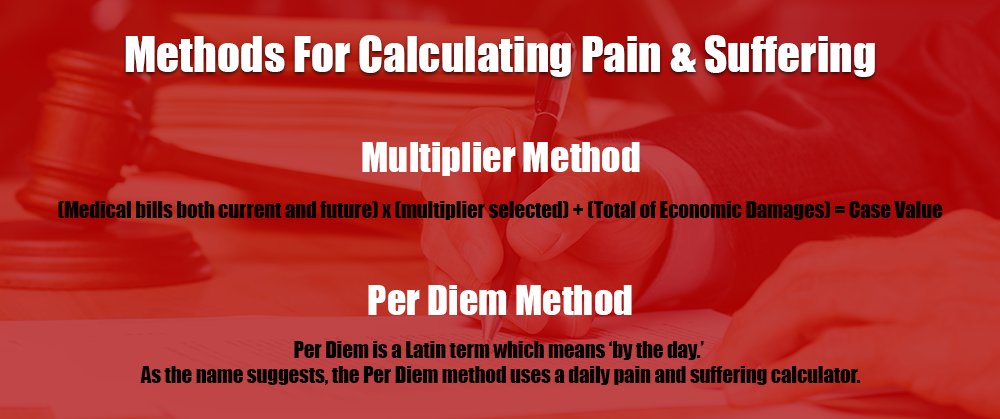
calculating for pain and suffering, pain and suffering compensation, what is pain and suffering, economic damages, non-economic damages, proving pain and suffering, pain and suffering limitations
The term “pain and suffering” is a collective term many people have heard; however, most may not know it is the primary component in a personal injury case.
There are two classifications of pain and suffering, physical and mental pain and suffering.
Physical pain and suffering is the physical stress brought on by injuries from an accident. It includes pain the victim has suffered and the future effects a victim may experience due to the at-faults negligence.
Mental pain and suffering resulting from the physical injuries a victim suffers but is more closely related to the unexpected consequence of those injuries. It includes conditions such as emotional distress, loss of enjoyment of life, mental anguish, anxiety, anger, fear, and many more significant issues such as depression, sleep disruption, anger, loss of appetite, and mood swings. Mental pain and suffering are, in essence, the negative feelings an injured victim endures as a direct result of physical injuries from an accident.
Like physical pain and suffering, mental pain and suffering include the effects suffered from the date of the accident and the likelihood of future suffering.
How is Pain and Suffering Categorized?
Economic Damages
According to Florida’s law, after establishing that the defendant is at fault, the victim can claim for both economic and non-economic damages in compensation. Economic damages, also known as special damages, are the losses that can be calculated easily. They comprise of the measurable items such as:
- Medical bills
- Loss of income – for both missed work, and for future loss of revenue if you’re unable to work again
- The increased cost of living
- Expenditure that you have incurred because of the accident which has a set dollar amount.
Economic damages are easy to present and justify in the form of bills and receipts. You can compensate for such damages because the jury views these bills and receipt as proof and, thus, are readily willing to pay for the losses.

how is pain and suffering categorized, economic damages, non-economic damages
Non-Economic Damages
However, the challenge arises when it comes to making non-economic damage or general damage claims such as pain and suffering. That is because compensation for pain and suffering is not easy to calculate. It is more than just physical pain. It also entails mental trauma and emotional stress that the victim goes through after an accident and during the recovery phase.
Examples of non-economic/general damages include:
- Physical pain
- Mental pain and anguish such as stress, disability or disfigurement
- Lower quality of life such as immobility
- Loss of companionship
- Loss of career especially, when you can’t work at the position that you once worked for before the accident
The victim can file a claim for pain and suffering if they are afflicted by stress, grief, worry, insomnia, depression, or the loss of enjoyment of life or any other issue that may impact them in any aspect after the accident. However, as non-economic damages are subjective, it is hard to justify, prove, and calculate.
If you too are in a similar situation and don’t know how much money can you sue for pain and suffering, then this post is a good read for you. Read on to develop a good understanding of pain and suffering, methods to calculate the claim amount, and the documents that you may need to prove the amount claimed.
How to Prove Pain and Suffering?
If you’re planning to claim pain and suffering incurred because of the accident, then it is advisable to document evidence for it. According to our experienced personal injury lawyer in Florida, here are the documents that can help you convey and justify the money you want to claim for pain and suffering:
- A written or documented opinion of a doctor or mental health expert that serves as a testimony to the state of mind of the victim.
- A written or recorded advice of a doctor or mental health expert that serves as a testimony to the victim’s pain (regardless of whether or not the pain and suffering can be used for legal purposes).
- A written or documented opinion of an expert in the field of personal injury that testifies, in general, the intricacies of the pain and suffering involved after an accident.
- Documentation of the medication prescribed for the victim for physical pain and mental issues.
- You, the victims’, verbal or written testimony for the pain and suffering.
- A written or oral statement of your family and friends testifying your pain and suffering.
In addition to these documents and testimonies, another great way to increase you claim to work with a lawyer. A seasoned personal injury lawyer can help you construct an objective statement of the duties and responsibilities you could perform before the accident and no longer do after getting injured.

how to prove pain and suffering, documents to support pain and suffering
This type of testimony is quite helpful. It can be extremely beneficial in front of a jury. A lawyer can help you write an impactful statement relatable to the panel after all the jury members are humans. Jury members can easily relate to and sympathize with issues of pain and suffering, such as:
- “I can no longer go to work.”
- “I can no longer pick up my children.”
- “I cannot bathe my children.”
- “I cannot perform duties that require long hours of sitting in front of the computer or standing behind the counter.”
According to the Florida Standard Jury Instruction 501.2, there’s no exact standard that can be used to measure the damages related to pain and suffering. So, the amount is predominantly decided in light of the evidence.
How is Compensation for Pain and Suffering Calculated?
Since no two accidents or injuries are the same and can affect each individual differently, it is tough to calculate the exact amount for a pain and suffering claim. Also, as mentioned above, the money you can sue for pain and suffering is dependent on the testimonies and evidence presented by you. So, when a judge or jury evaluates your case, they will consider evidence and information such as:
- Your age
- The type and severity of injuries incurred
- How your injuries affect your life – including how it has impacted your ability to work, enjoy hobbies, socialize, perform household chores, and other day-to-day activities.
However, based on the evidence, a personal injury lawyer can help you calculate a reasonable amount of money to resolve your claim through negotiation with the insurance company. A personal injury lawyer may first look at different factors to answer the basic questions for calculating pain and suffering compensation. This includes:
- How severe was your injury?
- Will there be an ongoing need for physical therapy or medical treatment?
- How old were you at the time of the accident?
- Were you suffering from pre-existing medical conditions?
- What is the level of your economic loss?
Moreover, a lawyer may utilize the following calculation methods to calculate a rough estimate:
Multiplier Method
In this method, you first add up all actual damages (also known as special damages or economic damages). Then, this amount is then multiplied by a number between 1.5 and 5. The number that you select to multiply is referred to as the multiplier. This number is indicative of the degree of seriousness of general damages that you may have suffered.
General damages are damages that aren’t specifically monetary. They include damages like pain and suffering, emotional trauma, and loss of consortium. There is no receipt or bill for these damages, but they are nonetheless losses for which an injured individual deserves compensation.
The multiplier method is based on the concept that the pain and suffering of the victim are worth at least 1.5 times the economic cost of repairing that injury.
Multiplier Method formula:
(Medical bills both current and future) x (multiplier selected) + (Total of Economic Damages) = Case Value
The crucial aspect of this entire equation is the multiplier. The insurance company and your injury lawyer in Florida shall evaluate the above factors to decide the severity of the injuries and your pain and suffering. Remember that the more severe the injury, the more your number is multiplied.
Let’s take a look at an example to understand the multiplier method:
Suppose a person has a medical expense of $5000 because of a spine injury. This figure is multiplied by three. His would determine their pain and suffering to be $15,000. Thus, this figure will then be added to its original $5000 to develop an estimated value. In this situation, the case value will be $20,000.
It is essential to understand that the insurer and victim will most often have different opinions for multiplier selection. The insurance company will always select a low multiplier to limit their liability claim while the victim (plaintiff) will seek a higher multiplier. However, with an attorney to represent your case rest assured, they will select the right multiplier for your case based on their experience, expertise, and calculations supported by accurate facts and documentation.
Some factors that should be considered for determining an appropriate multiplier for your pain and suffering include:
- The obviousness of the other driver’s fault
- The seriousness of the injuries such as permanent disability
- Verified documents showing clear proof of pain and suffering
- Recovery timeframe
However, keep in mind that the calculated amount with the multiplier method is only an estimate. Therefore, there is no guarantee that you’ll receive the exact amount.

calculating pain and suffering, methods for pain and suffering calculations, multiplier method, per diem method
Per Diem Method
The per diem method is another method for the calculation of pain and suffering. Per Diem is a Latin term which means ‘by the day.’ As the name suggests, the Per Diem method uses a daily pain and suffering calculator. This method is used to pay out a specific dollar amount daily from when the accident occurred until the patient reaches their maximum medical improvement. The sum paid daily is quite reasonable, such as $100 per day. This amount is only for pain and suffering. Thus, an additional amount shall be awarded for medical treatment, income loss, and property damage.
Per Diem example:
Suppose someone is injured in a motorcycle accident on 5th June. They are deemed to have recovered after a cast and physical therapy on 20th November. This is 169 days. Therefore, with the Per diem method’s help, 169 days multiplied by $100 a day equals $16,900. In other words, the total payout will be $16,900 but disbursed on a per-day basis.
The Job Description like Method
Besides the two methods for calculating a rough estimate for pain and suffering claim, another calculation method is the job description-like method. Although not commonly used, it still is useful for determining the amount of pain and suffering.
The method primarily focuses on writing down the pain and suffering as if it were a job description. For example, what would an individual need to be paid to execute specific duties? Let’s suppose if a car crash puts the victim in a wheelchair and makes them disable temporarily for about six months, then how much they’d be paid to it in the wheelchair daily for six months? So, would you sit in a wheelchair for $5000 for six months or charge more? The best way to determine charges is to use the medical professional’s daily rate that treated the injury.
However, many people use different ways to determine charges; it is recommended to choose a method that makes sense so that the court and jury agree with how you calculated the figure. In some situations, focus groups are used. These groups determine the daily rate/charges after hearing the facts of the case. For example, 20 people focus group believes that the victim should be offered at least $40,000 for pain and suffering, then this estimate can be used to determine the starting point.
Which Method Will Be Used In My Situation?
As insurance companies are not obligated to use the methods discussed above for determining pain and suffering damages, you can never be 100 percent sure which way they will use in your case.
They can also use in-house computer programs to determine your claim amount.
Insurance companies only consider injuries treated by medical specialists and doctors to be severe than the injuries treated by a chiropractor. Besides this, they sometimes even do their reasoning or rely on past numbers to determine the amount for your pain and suffering case.
For example, if they previously paid $10,000 for pain and suffering for spinal damage, they would pay either the same or lower amount to you for the same injury. Sometimes this can be unfair, but that is where your attorney will come into action, negotiating aggressively for fair compensation.
With an experienced personal injury attorney in Florida for legal representation, you can focus on your recovery. At the same time, they handle all aspects of your case to get you full and fair compensation. This is where we come into the picture.
Our personal injury lawyer has the experience, expertise, and legal knowledge at Shiner Law Group to handle pain and suffering claims and get the clients the amount they deserve. We never settle for less. Our lawyer will negotiate aggressively with the insurance company for the compensation that you’re entitled to. However, if the insurance company doesn’t agree, which rarely happens, our lawyer is adept and experienced in taking cases to trial.
Our seasoned personal injury lawyer will adequately illustrate your pain and suffering case at trial for the jury. We ensure that the jurors understand your situation and the pain and suffering that you are going through because of the accident that occurred due to someone else’s fault and negligence. At Shiner Law Group, our lawyer makes sure that the jury fully understands and relates to your suffering because that is the only way they can agree to the amount claimed by you.
As mentioned earlier, it is easy for jurors to determine the compensation amount for economic/special damage because the numbers are precise. They have evidence to rely on, such as medical bills and documented loss of income. However, placing a monetary value on pain and suffering is a challenge because it is subjective and abstract.
Abstract concepts, confusion, and ambiguity are the tactics that the defense attorney may use in the court o dismantle the viability of your claim. But being experienced in this domain, our lawyer knows how to counter it and illustrate your pain and suffering damages in the most convincing way possible to get the amount you are entitled to.
By leveraging our expertise, we can also increase the awarded amount for pain and suffering. Here’s how:
To ensure you receive a fair amount, our lawyer strives to collect more evidence: the more reliable indication that you have, the better. From documentary evidence like medical records to witness statements needed to establish the scope of pain and suffering to testimonies, our lawyer will gather them all.
Before and after witnesses are extremely helpful for justifying your pain and suffering claim amount. This is because these witnesses are people who knew you before and after the incident. Their statements truly matter as they are equipped to testify how the accident impacted you and your life.
Your spouse, family members, and friends can serve as before and after witnesses because they have known you before the accident and quickly identify the challenges and misery you have to go through due to the injuries caused by accident. However, our lawyer does not solely rely on them.
This is because these witnesses are inherently biased. After all, they care for you, and thus, they are more likely to be attacked by the defense. So, possibly the best before and after witnesses are people who don’t have any personal stake in the litigation, such as your co-workers, neighbors, and employer. These are individuals you know but don’t live with.
They can provide unbiased opinions about the changes they have seen in you before and after the accident. These witnesses can provide firsthand knowledge regarding the effects of the injuries on you, your work performance, and the pain and suffering that you are going through.
Limitations on Pain and Suffering in Florida
There are several limitations to a personal injury lawsuit in Florida, such as time. You only have two years to file a personal injury lawsuit and make a claim for special and general damages under the states’ statute of limitations. Your time starts on the day of the accident.
Also, the other limitation is the amount that you, the plaintiff, can sue for. In general, there is no cap on the amount of damages that can be awarded for pain and suffering. If the lawsuit is related to medical malpractice, then there is a limit of $500,000, which can be awarded.
Also, as Florida is a no-fault state, this rule can impact the amount that you can receive in compensation after the accident. It mostly happens in auto accidents.
As the insurance company pays for the damages regardless of who was at fault, it becomes tough to get awarded for the insurance company’s pain and suffering. This is because the insurance company focuses on just limiting its liability claim. However, if you have a lawyer to represent your case, things can become easy and smooth.
Time to Get Personal
To get fairly compensated for the pain and suffering, you need to be honest with your lawyer regarding your life’s limitations. Sometimes it can be challenging for a person to admit how their life has been negatively impacted, but it’s essential to share all the details with the lawyer to build a strong case.
It may be easy to talk about physical limitations like engaging in water sports or going for a basketball game. However, sometimes injuries can also cause emotional complications like anxiety, insomnia, stress, or a loss of intimacy. All these factors can impact your final settlement award.
Therefore, make sure to share all the relevant information about the accident, and your pain and suffering, with your injury attorney without hesitation. They need to present the entire “picture” to justify the scope of damages and get you fair compensation for special damages and general damages.
Call Us Today For Case Evaluation and Representation
Schedule for an initial consultation with our experienced personal injury lawyer today to discuss your case and pain and suffering caused due to the accident. Allow our lawyer to assess your situation and determine the best course of legal action to pursue your case and get you the compensation that you rightfully deserve. Let us help maximize the pain and suffering amount of your claim. Call us now before the statute of limitations expires.